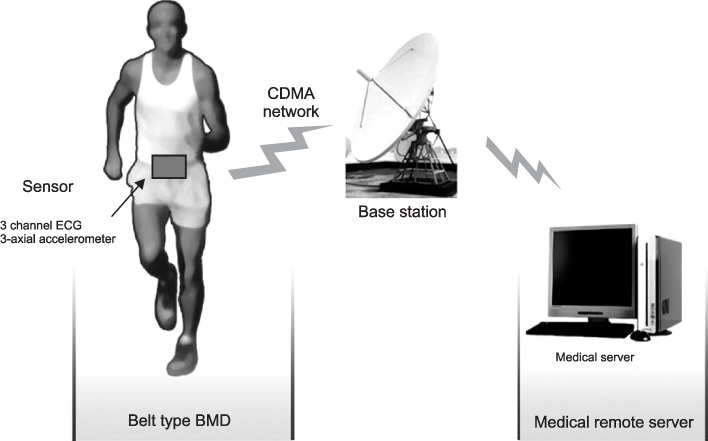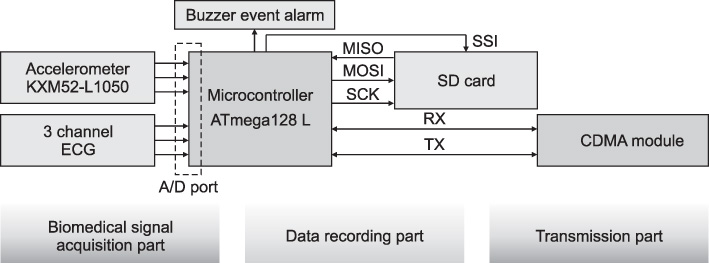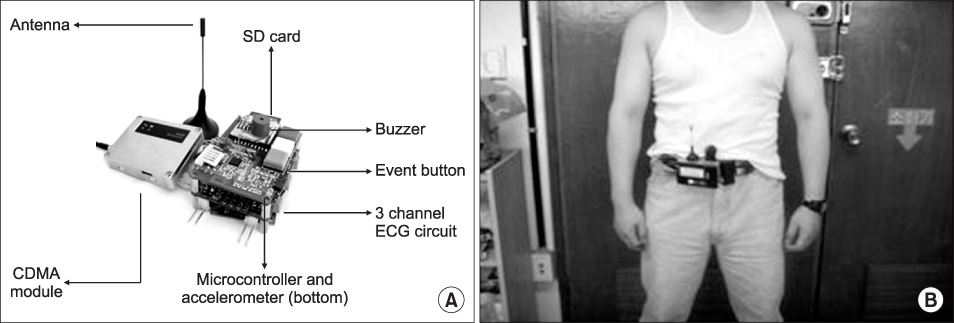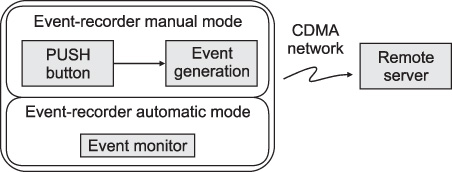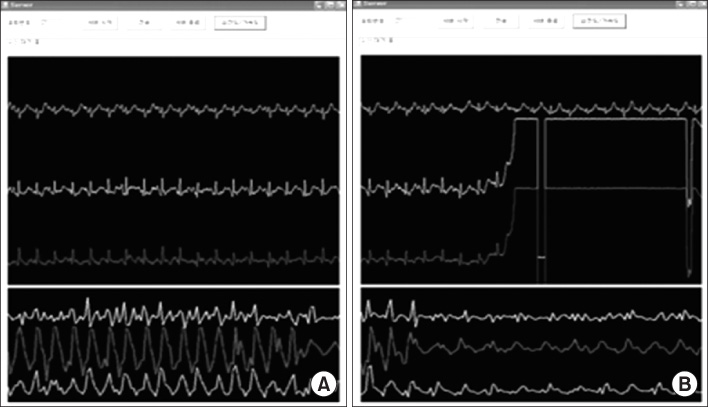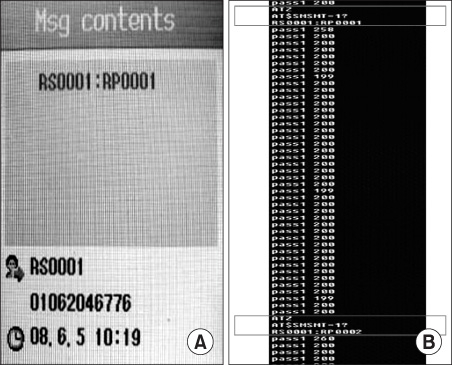J Korean Soc Med Inform.
2009 Sep;15(3):351-358.
A Belt-type Biomedical Mobile Device
- Affiliations
-
- 1Department of Biomedical Engineering, College of Medicine, Chungbuk National University, Korea. tslee@chungbuk.ac.kr
Abstract
OBJECTIVE
To investigate a belt-type, biomedical mobile device capable of measuring patients' biomedical signals and sending the biomedical data to a remote medical server. This device was designed to measure and record ECG and motion signals continuously for a moving subject and, on in the event of an emergent situation, to notify a remote doctor of the situation by transmitting data on the emergent situation to a remote server through a CDMA network.
METHODS
The developed system is composed of three parts: biomedical signal acquisition, biomedical data recording, and data transmission. We conducted four types of experiment in order to evaluate the developed system's accuracy, reliability, operability, applicability to daily life, and SMS alarm function. First, we tested the accuracy of the R-R interval by comparing the signals measured via the developed system with those via a commercialized ECG system while the subjects were sitting, standing, lying or cycling. Second, we tested the reliability of the transmitted data to the remote server when two types of emergent events are generated in the developed system using a patient simulator, and measured the battery life to determine the system life. Third, we experimentally examined the accuracy of the corresponding data transmitted to the remote server via the CDMA network when two types of event are generated for each of seven types of action (sitting, standing, standing up from the seat, ordinary walking, fast walking, cycling, and running) during daily life. Lastly, we tested the SMS alarm function.
RESULTS
The acquisition and comparison of the subjects' biomedical signals and motion signals confirmed the accuracy, reliability, operability and applicability of the developed system to daily life. The ability of the system to monitor the ECG signals and motion signals during daily life was also demonstrated.
CONCLUSION
The system was demonstrated to be very applicable to subjects requiring continuous monitoring for chronic disease and health management. Therefore, the developed system is expected to play an important role in building ubiquitous healthcare systems in Korea in the near future.
MeSH Terms
Figure
Reference
-
1. Lorincz K, Malan DJ, Fulford-Jones TRF, Nawoj A, Clavel A, Shnayder V, et al. Sensor networks for emergency response: challenges and opportunities. IEEE Perv Comput. 2004. 3(4):16–23.
Article2. Anliker U, Ward JA, Lukowicz P, Troster G, Dolveck F, Baer M, et al. AMON: a wearable multiparameter medical monitoring and alert system. IEEE Trans Inf Technol Biomed. 2004. 8(4):415–427.
Article3. Accessed Jun 18, 2009. Available at: http://www.vivometrics.com.4. Accessed Jun 18, 2009. Available at: http://lifeguard.stanford.edu.5. Jovanov E, Milenkovic A, Otto C, De Groen P, Johnson B, Warren S, et al. A WBAN System for Ambulatory Monitoring of Physical Activity and Health Status: Applications and Challenges. In : In Proc. 27th Annu. 2005 IEEE Int. Conf. Shanghai; 2005 Sept 1-4; Shanghai, China.6. Foerster F, Smeja M, Fahrenberg J. Detection of Posture and Motion by accelerometry: a Validation study in ambulatory monitoring. Comput Hum Beh. 1999. 15(5):571–583.
Article7. Jovanov E, Milenkovic A, Otto C, Groen PCD. A wireless body area network of intelligent motion sensors for computer assisted physical rehabilitation. J Neuroeng Rehabil. 2005. 2:6.
Article8. Hong JH, Kim NJ, Cha EJ, Lee TS. Development brief of a body area network for ubiquitous healthcare: an introduction to ubiquitous biomedical systems development center. J Biomed Eng Res. 2005. 26(5):331–335.9. Asada HH, Shaltis P, Reisner A, Rhee SW, Hutchinson RC. Mobile monitoring with wearable photoplethysmographic biosensors. IEEE Eng Med Biol Mag. 2003. 22(3):28–40.
Article10. Ceer D. Pervasive medical devices: less invasive, more productive. IEEE Perv Comput. 2006. 5(2):85–88.
Article11. Mundt CW, Montgomery KN, Udoh UE, Barker VN, Thonier GC, Tellier AM, et al. A multiparameter wearable physiologic monitoring system for space and terrestrial applications. IEEE Trans Inf Technol Biomed. 2005. 9(3):382–391.
Article
- Full Text Links
- Actions
-
Cited
- CITED
-
- Close
- Share
- Similar articles
-
- Appendiceal transection associated with seat belt restraint
- A Belt-type Biomedical Mobile Device
- Design of Wired/Wireless Integrated Medical Information Management System Based on Web Service
- Development of a flexible chest electrode belt for continuous ECG measurement
- Electro-Mechanical Safety Testing of Portable ECG Devices for Home Healthcare Usage

